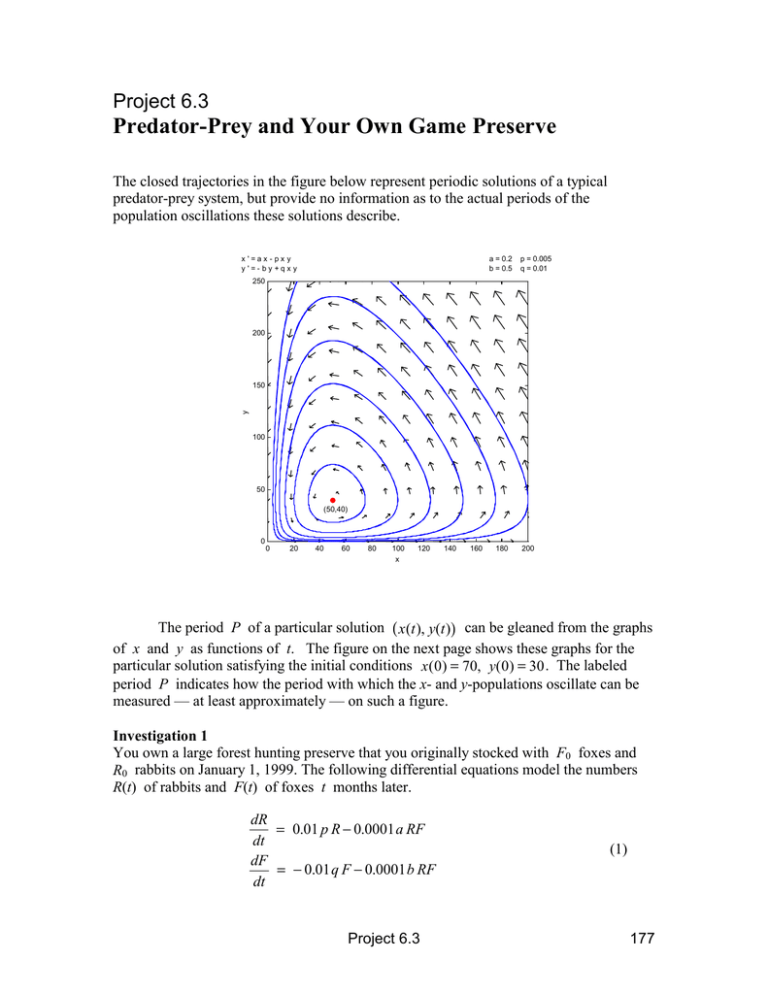Predator-Prey and Your Own Game Preserve Project 6.3
advertisement

Project 6.3
Predator-Prey and Your Own Game Preserve
The closed trajectories in the figure below represent periodic solutions of a typical
predator-prey system, but provide no information as to the actual periods of the
population oscillations these solutions describe.
x '=ax - px y
y '=- by +qx y
a = 0.2
b = 0.5
p = 0.005
q = 0.01
250
200
y
150
100
50
(50,40)
0
0
20
40
60
80
100
x
120
140
160
180
200
#
The period P of a particular solution x (t ), y(t ) can be gleaned from the graphs
of x and y as functions of t. The figure on the next page shows these graphs for the
particular solution satisfying the initial conditions x ( 0) = 70, y( 0) = 30 . The labeled
period P indicates how the period with which the x- and y-populations oscillate can be
measured — at least approximately — on such a figure.
Investigation 1
You own a large forest hunting preserve that you originally stocked with F0 foxes and
R0 rabbits on January 1, 1999. The following differential equations model the numbers
R(t) of rabbits and F(t) of foxes t months later.
dR
= 0.01 p R − 0.0001 a RF
dt
dF
= − 0.01 q F − 0.0001 b RF
dt
Project 6.3
(1)
177
80
70
60
x(t)
50
x,y
40
30
y(t)
20
P
10
0
0
10
20
30
40
t
50
60
70
80
where p and q are the two largest digits (with p < q) , and a and b are the two
smallest nonzero digits (with a < b) in your student ID number.
The numbers of foxes and rabbits will oscillate periodically, out of phase with
each other (like the functions x (t ) and y(t ) in the figure above). Pick your initial
numbers F0 of foxes and R0 of rabbits -- perhaps several hundred of each -- so that the
resulting solution curve in the RF-plane is a fairly eccentric closed curve. (The
eccentricity may be increased if you start with a largish number of rabbits and a smallish
number of foxes, as any hunting preserve owner would naturally do -- since foxes eat
rabbits.)
Your task then is to determine
•
•
•
The period of oscillation of the rabbit and fox populations;
The maximum and minimum numbers of rabbits, and the calendar dates on which
they first occur; and
The maximum and minimum numbers of foxes, and the calendar dates on which
they first occur.
With computer software that can plot both RF-trajectories and tR- and tF-solution
curves like those above, you can "zoom in" graphically on the points whose coordinates
provide the requested information.
178
Chapter 6
x ' = 14 x - 2 x 2 - x y
y ' = 16 y - 2 y 2 - x y
10
9
8
(0,8)
7
(4,6)
y
6
5
4
3
2
1
0
(0,0)
0
(7,0)
1
2
3
4
5
x
6
7
8
9
10
Investigation 2
For a more general ecological system to investigate, let a, b, c, d be the four smallest
nonzero digits (in any order) and m, n the two largest digits in your student ID number.
Then consider the system
dx
dt
= x( P − ax ± by) ,
dy
dt
= y(Q ± cx − dy)
(2)
Where P = ma − ( ± nb) and Q = nd − ( ± mc ) , with the same choice of plus/minus
signs in dx/dt and P and (independently) in dy/dt and Q — so that (m, n) is a critical
point of the system. Then use the methods of Project 6.1 to plot a phase plane portrait for
this system in the first quadrant of the xy-plane. In particular, determine the long-term
behavior (as t → ∞ ) of the two populations, in terms of their initial populations x(0) =
x0 and y(0) = y0. For instance, the figure above shows a phase plane portrait for the
system
dx
dt
= x (14 − 2 x − y) ,
dy
dt
= y(16 − x − 2 y) .
Project 6.3
179
We see a nodal source at (0, 0), a nodal sink at (4, 6), and saddle points at (7, 0) and
(0, 8). It follows that, if x0 and y0 are both positive, then x(t) → 4 and y(t) → 6 as
t →∞.
In the sections that follow we use the simple predator-prey system
dx
= x − xy,
dt
dy
− y + xy .
dt
(3)
to illustrate the Maple, Mathematica, and MATLAB techniques needed for these
investigations.
Using Maple
To plot a solution curve for the system in (3) we need only load the DEtools package and
use the DEplot function. For instance, if we first define the differential equations
deq1 :=
deq2 :=
diff(x(t),t) = x - x*y:
diff(y(t),t) = -y + x*y:
then the commands
with(DEtools):
DEplot([deq1,deq2], [x,y], t=0..25,
{[x(0)=1, y(0)=3]}, stepsize=0.1,
linecolor=blue, arrows=none);
plot the xy-solution curve with initial conditions x(0) = 1, y(0) = 3 on the interval
0 ≤ t ≤ 25 with step size h = 0.1. Next, the command
DEplot([deq1,deq2], [x,y], t=0..25,
{[x(0)=1, y(0)=3]}, stepsize=0.1,
scene = [t,x], linecolor=blue, arrows=none);
plots the corresponding tx-solution curve, on which the approximate period of oscillation
of the prey population can be measured.
Using Mathematica
To plot a solution curve for the system in (3) we need only define the differential
equations
deq1 = x'[t] == x[t] - x[t]*y[t];
deq2 = y'[t] == -y[t] + x[t]*y[t];
180
Chapter 6
and then use NDSolve to integrate numerically. For instance, the command
soln = NDSolve[ {deq1,deq2, x[0]==1, y[0]==3},
{x[t],y[t]}, {t,0,25} ]
yields an approximate solution on the interval 0 ≤ t ≤ 25 satisfying the initial conditions
x(0) = 1, y (0) = 3 . Then the command
ParametricPlot[
Evaluate[{x[t],y[t]} /. soln], {t,0,25}]
plots the corresponding xy-solution curve, and the command
Plot[Evaluate[ x[t] /. soln ], {t,0,25}]
plots the corresponding tx-solution curve, on which the approximate period of oscillation
of the prey population can be measured.
Using MATLAB
To plot a solution curve for the system in (3) we need only define the system by means of
the m-file
function yp = predprey(t,y)
% predprey.m
yp = y;
x = y(1);
y = y(2);
yp(1) = x - x.*y;
yp(2) = -y + x.*y;
and then use ode23 to integrate numerically. For instance, the command
[t,x] = ode23('predprey', [0:0.1:25], [1;3]);
yields an approximate solution on the interval 0 ≤ t ≤ 25 satisfying the initial conditions
x(0) = 1, y(0) = 3 . Then the command
plot(x(:,1), x(:,2))
plots the corresponding xy-solution curve, and the command
plot(t, x(:,1))
plots the corresponding tx-solution curve, on which the approximate period of oscillation
of the prey population can be measured.
Project 6.3
181







